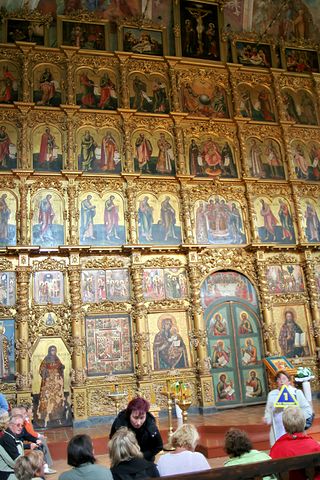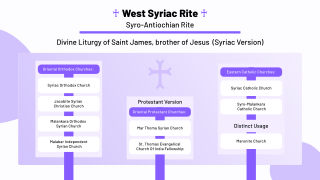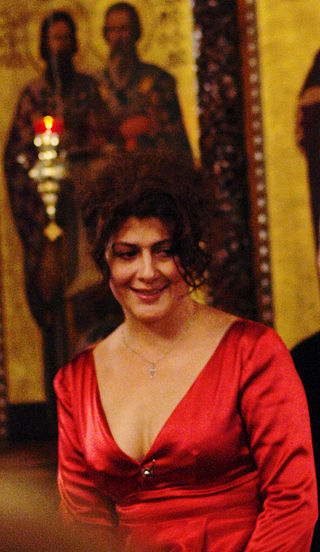
Kassia, Cassia or Kassiani was a Byzantine-Greek composer, hymnographer and poet. She holds a unique place in Byzantine music as the only known woman whose music appears in the Byzantine liturgy. Approximately fifty of her hymns are extant, most of which are stichera, though at least 26 have uncertain attribution. The authenticity issues are due to many hymns being anonymous, and others ascribed to different authors in different manuscripts. She was an abbess of a convent in the west of Constantinople.

The Byzantine Rite, also known as the Greek Rite or the Rite of Constantinople, is a liturgical rite that is identified with the wide range of cultural, devotional, and canonical practices that developed in the Eastern Christian church of Constantinople.

The Liturgy of Saint James is a form of Christian liturgy used by some Eastern Christians of the Byzantine rite and West Syriac Rite. It is developed from an ancient Egyptian form of the Basilean anaphoric family, and is influenced by the traditions of the rite of the Church of Jerusalem, as the Mystagogic Catecheses of Cyril of Jerusalem imply. It became widespread in Church of Antioch from the fourth or fifth century onwards, replacing the older Basilean Liturgy of Antioch. It is still the principal liturgy of the Syriac Orthodox Church, the Malankara Orthodox Syrian Church, the Maronite Church, the Syriac Catholic Church, Syro-Malankara Catholic Church and other churches employing the West Syriac Rite. It is also occasionally used in the Eastern Orthodox Church and Melkite Catholic Church. The Malankara Mar Thoma Syrian Church uses a reformed variant of this liturgy, omitting intercession of saints and prayer for the dead.

Ecce homo are the Latin words used by Pontius Pilate in the Vulgate translation of the Gospel of John, when he presents a scourged Jesus, bound and crowned with thorns, to a hostile crowd shortly before his Crucifixion. The original New Testament Greek: "ἰδοὺ ὁ ἄνθρωπος", romanized: "idoù ho ánthropos", is rendered by most English Bible translations, e.g. the Douay-Rheims Bible and the King James Version, as "behold the man". The scene has been widely depicted in Christian art.
Orthros or útrenya, in the Byzantine Rite of the Eastern Orthodox Church and the Eastern Catholic Churches, is the last of the four night offices, the other three being vespers, compline, and midnight office. Traditionally, in monasteries it is held daily so as to end immediately following sunrise, in contrast to parishes where it is held only on Sundays and feast days. It is often called matins after the office it most nearly corresponds to in Western Christian churches.
Cosmas of Maiuma, also called Cosmas Hagiopolites, Cosmas of Jerusalem, Cosmas the Melodist, or Cosmas the Poet, was a bishop and an important hymnographer in the East. He is venerated as a saint by the Eastern Orthodox Church and the Catholic Church.

The Trisagion, sometimes called by its opening line Agios O Theos, is a standard hymn of the Divine Liturgy in most of the Eastern Orthodox, Western Orthodox, Oriental Orthodox, and Eastern Catholic churches.
A kontakion is a form of hymn in the Byzantine liturgical tradition.

Romanos the Melodist was a Byzantine hymnographer and composer, who is a central early figure in the history of Byzantine music. Called "the Pindar of rhythmic poetry", he flourished during the sixth century, though the earliest manuscripts of his works are dated centuries after this. He was the foremost Kontakion composer of his time.
A canon is a structured hymn used in a number of Eastern Orthodox services. It consists of nine odes, based on the Biblical canticles. Most of these are found in the Old Testament, but the final ode is taken from the Magnificat and Song of Zechariah from the New Testament.

Antiochene Rite also known as Antiochian Rite refers to the family of liturgies originally used by the patriarch of Antioch.

A typikon is a liturgical book which contains instructions about the order of the Byzantine Rite office and variable hymns of the Divine Liturgy.
Eastern Orthodox worship in this article is distinguished from Eastern Orthodox prayer in that 'worship' refers to the activity of the Christian Church as a body offering up prayers to God while 'prayer' refers to the individual devotional traditions of the Orthodox.
The Lity or Litiyá is a festive religious procession, followed by intercessions, which augments great vespers in the Eastern Orthodox and Byzantine Catholic churches on important feast days. Following a lity is another liturgical action, an artoklasia, and either of these terms may be used to describe both liturgical actions collectively.

The Paschal Hours are the form in which the Little Hours are chanted on Pascha (Easter) and throughout Bright Week in the Eastern Orthodox and Byzantine Catholic churches.
The Megalynarion is a special hymn used in the Eastern Orthodox Church and those Eastern Catholic Churches that follow the Byzantine Rite. Depending on the local liturgical tradition, this hymn can be one of several.
Mme. Delaval or Madame De La Valle, birthname Adélaïde-Suzanne-Camille Larrivée, was a French harpist, pianist and composer. Delaval was born in Paris, France to opera singers Henri Larrivée and Marie-Jeanne Larrivée Lemière. She had one sister, Agathe-Elisabeth-Henriette, who was given violin lessons while Adelaide focused on the harp. Both girls were students of Jean-Baptiste Krumpholtz. When their parents separated in 1767, the girls provided for their guardian and aunt, Elisabeth-Henriette Larrivée, by touring through French provinces in concerts.
Eileen Malone was an American harpist and music educator.

Divna Ljubojević, sometimes called by just her first name, Divna, is a Serbian singer and conductor of Orthodox Christian sacred music in various languages. She is the conductor and artistic director of the Melodi ensemble, a "choir and studio for spiritual music". which she founded with a group of her friends.
Agathe Elisabeth Henriette Larrivée, also L'Arrivée, was a French violinist, pianist and composer. She had studied under the composer and harpist Jean-Baptiste Krumpholz. In the late 1780s, she performed in the French provinces with her father, the opera singer Henri Larrivée, her mother, the soprano Marie-Jeanne Larrivée Lemière, and her sister Camille, a harpist. Thereafter she performed as both a pianist and violinist with her sister in London. After marrying the composer Antonio Borghese (1745–1806), Henriette performed with him in France in 1799. She also composed at least two works including a trio sonata for piano, violin and bass.









